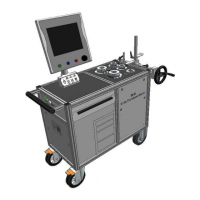Appendix B: Processes and Statistics BLM 3750 User Guide
70 (78) 9836 3078 01 Edition 2.0
12 APPENDIX B: Processes and Statistics
BRIEF NOTES ON HOW THE PROCESS WORKS
The functioning of a process is a measure of its reliability. A certain amount of variability can be found in
each process due to:
- Natural causes
- Determinable causes
While the first type of variability is quite normal in a process, being attributable to ordinary causes, the
second type is linked to specific or special causes: If suitably adjusted or controlled, the relative variability
can be eliminated.
Since the variability in the process can be described as a single distribution, usually normal, the
functioning or capacity can be assessed using the properties of this distribution.
Evaluation of the functioning of the process allows you to make predictions as to its quality and thus adopt
the appropriate measures to avoid possible defects.
Normal distribution
The manner in which each value falls around the most frequently found value (the mean value) is called
distribution. Normal (or Gaussian) distribution is the frequency distribution that a magnitude usually tends
towards when it undergoes a large number of accidental causes of variation, each of which acts
independently of the others and with a very small effect when compared to the sum of all of the effects.
Normal distribution is represented by a bell-shaped curve with several interesting features.
Without going into the details of the mathematical and statistical concepts involved, we still need to
explain the meaning of the mean value (the sum of the values divided by their number),
and the calculation of the standard deviation, indicated by σ (sigma) and expressed as the square root of
the mean of the deviation squares:
XXXX
N
22
3
2
2
2
1
++++
=
σ
Statistical studies show that if the process is distributed in a normal fashion, the dispersion of the values
around the mean value is as follows:
- 68.26% of the values fall within ±1 standard deviation (±1
)
- 95.44% of the values fall within ±2 standard deviation (±2
)
- 99.73% of the values fall within ±3 standard deviation (±3
)
- 99.994% of the values fall within ±4 standard deviation (±4
)

